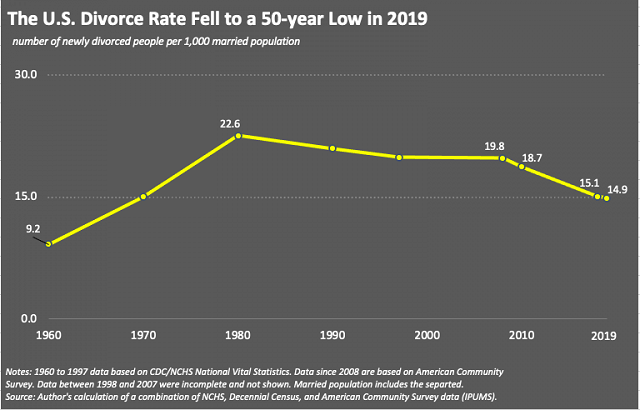Declining Divorce Rate
“Fifty percent of all marriages end in divorce.” Or so you’ve heard.
That oft-repeated statistic may once have been true; it isn’t any longer.
In fact, since the mid 1980s, the divorce rate has fallen steadily and substantially, reaching a 50-year low in 2019.
Researcher Wendy Wang writes for the Institute for Family Studies, “For every 1,000 marriages in the last year, only 14.9 ended in divorce. This is the lowest rate we have seen in 50 years,” adding, “It is even slightly lower than 1970, when 15 marriages ended in divorce per 1,000 marriages.”

Photo Credit: Institute for Family Studies
Brad Wilcox, director of the National Marriage Project and senior fellow at the Institute for Family Studies, recently responded to a tweet from YouTube commenter H. Pearl Davis who wrote, “Most people are not special. They are the stats. … Half the people pushing [marriage] will be divorced.”
“Don’t fall for the Red Pill take on marriage,” Wilcox writes. “Divorce is down dramatically since 1980. No longer true that have of marriages end in divorce.”
Wilcox adds, “Today, most marriages will make it,” noting that the divorce rate is especially low for couples who:
- Attend church together;
- Are college-educated;
- Have regular date nights;
- Have a husband who is employed.
He continues:
More seriously, I know that not everyone can or should marry and that our laws, culture & economy do not do enough to sustain strong and stable marriages.
But for most men and women, marriage is the way.
Nothing compares to marriage (and a family) when it comes to giving the…
— Brad Wilcox (@BradWilcoxIFS) September 24, 2023
The Reasons Why
The trend of declining divorce is certainly something to celebrate.
From the very first chapter in Genesis, we learn that God created marriage as the first and most basic human institution. And Jesus clearly reiterated this truth in His own teachings as recorded in the book of Mark.
“But from the beginning of creation, ‘God made them male and female.’ ‘Therefore a man shall leave his father and mother and hold fast to his wife, and the two shall become one flesh.’ So they are no longer two but one flesh. What therefore God has joined together, let not man separate” (Mark 10, 6-9, ESV).
But why is divorce declining? Sociologists and demographers aren’t quite sure – though they have several educated guesses.
As one potential factor, fewer Americans are getting married in the first place – this is a factor that Wang has called the “selection effect.”

Photo Credit: Institute for Family Studies
And those who are getting married are generally college-educated and economically better off – both factors that make it more likely married couples will stay married.
It’s good that these factors may be contributing to the decline in divorce. However, it also indicates a widening “marriage divide” with working-class Americans facing rising rates of family instability, single parenthood and life-long singleness.
Wang’s analysis of the 2018 Census data found,
For Americans in the top third income bracket, 64% are in an intact marriage, meaning they have only married once and are still in their first marriage. In contrast, only 24% of Americans in the lower-third income bracket are in an intact marriage.
According to sociologist Philip Cohen, “the risk profile for newly married couples has shifted toward more protective characteristics” including couples obtaining higher education and being older at marriage. These factors reduce the odds of divorce and lead Cohen to predict that “divorce rates will further decline in the coming years.”
Another factor contributing to the decline in divorce is that individuals born during the Baby Boom period had uniquely high divorce rates – a factor referred to as the “gray divorce phenomenon.” As the number (and influence) of individuals in the Baby Boomer generation shrinks, so does the divorce rate.
Conclusion
Divorce rates are falling – they have been for 50 years. This is good news for all who care about marriage, and the stability of the family and the wellbeing of children.
Yet, there’s still much work to do to support family life. According to sociologist Paul Amato, the lifetime risk of divorce today may still be as high as 42 to 45%.
Additionally, rates of cohabitation remain spectacularly high – around 67% of the currently married have cohabited before marriage with one or more partners. Only 28% of women aged 15-44 disapprove of cohabitation along with 24.8% of men. And cohabitation before marriage is associated with far greater odds of divorce.
Marriage – the lifelong union of one man and one woman – is an institution designed and established by God.
In their union, man and wife reflect the image of the Trinity. “The Christian family is a communion of persons, a sign and image of the communion of the Father and the Son in the Holy Spirit. In the procreation and education of children it reflects the Father’s work of creation.” (CCC 2205).
Indeed, the wedded are called to a divine vocation. For matrimony offers the wedded the gifts of children, sexual fidelity and sanctification.
For these reasons, Satan hates marriage. And it is the job of every Christian to support, defend and promote this God-ordained institution.
Focus on the Family is presenting the upcoming two-day Resist the Drift Marriage Conference in Anaheim, CA from November 3-4. Attending couples will receive Bible-based concepts and tools from our trained marriage professionals on how to reconnect and strengthen their marriages. You can learn more about the upcoming conference here.
Also, if your marriage is struggling, Focus on the Family offers Hope Restored Marriage Intensives. Hope Restored is a biblically based, Christian counseling experience for couples facing a crisis moment in their marriage or suffering from years of disconnection and relationship decay. You can find out more about Hope Restored here.
Related articles and resources:
Counseling Consultation & Referrals
Why Marriage Matters for Adults
Focus on the Family: Marriage Assessment
Focus on the Family: Marriage Enrichment Events
What is Happening with Marriage Today? Some Good News, But Mostly Bad
Photo from Shutterstock.






